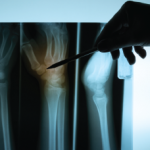More than half of Americans age 50 and older are at risk of a bone fracture caused by osteoporosis. Osteoporosis is easily preventable with existing diagnostic tools and inexpensive treatments that can reduce fractures. The dual-energy X-ray absorptiometry (DXA) test is considered the gold standard for bone density screening, yet many individuals who may be at risk of low bone mass are not tested due to low reimbursement rates. Osteoporosis testing has declined significantly since 2007, when Medicare reimbursement rates for DXA tests began to drop.
The ACR is working to counter this decline in effective osteoporosis testing. Bipartisan legislation has been introduced in both the U.S. House and Senate to set a minimum Medicare reimbursement of $98 for DXA scans. The ACR hopes to find additional co-sponsors for the Increasing Access to Osteoporosis Testing for Medicare Beneficiaries Act (H.R. 2693/S. 238) and help get it passed by the 116th Congress.
Bone fractures are associated with poor health outcomes and high medical costs. Among adults aged 50 and over who sustain a hip fracture, one in three dies within 12 months and one in four ends up in a nursing home.1 More women die each year from complications following hip fractures than from breast cancer. In 2018, annual direct medical costs associated with osteoporotic fracture were estimated to be $48.8 billion.2 By 2025, Medicare is projected to pay more than $25 billion each year for direct costs of new fractures. However, many of these outcomes are preventable. In one study, elderly female Medicare beneficiaries who received a DXA bone density test had a 19.6% lower fracture rate in the following three years than those who were not tested.3
A series of cuts reduced the Medicare reimbursement rate by more than 60% between 2006 and 2010.4 At the current rate, it is not economically feasible for many doctors to maintain the needed equipment and administer DXA tests. This means that fewer providers now offer DXA scans, even though the test is recommended for all women 65 and older and those younger than 65 with risk factors, as well as men at increased risk for osteoporosis.5,6
By setting a minimum payment for DXA testing, H.R. 2693/S. 238 can reverse this dangerous trend. Screening and treatment can mitigate the human and economic toll of osteoporosis. A recently published study found increased DXA screening could have substantial benefits, preventing 3.7 million fractures and reducing total direct medical costs of osteoporosis by nearly $55 billion through 2040.2
In October, Angus Worthing, MD, FACP, FACR, represented the ACR in a briefing on Capitol Hill on the dangers of the continued decline in DXA testing. The next morning, the Senate Committee on Aging, led by Sen. Susan Collins (R-Maine), held a hearing on the importance of fracture prevention for the wellness of our aging population.
We hope these efforts, together with communications from our members to their elected officials, will lead to the passage of this important legislation in Congress. Take a moment now to write to your lawmakers asking for their support of this important legislation. Our seniors simply cannot wait.
References
- Katsoulis M, Benetou V, Karapetyan T, et al. Excess mortality after hip fracture in elderly persons from Europe and the USA: The CHANCES project. J Intern Med. 2017 Mar;281(3):300–310.
- Lewiecki EM, Ortendahl JD, Vanderpuye-Orgle J, et al. Healthcare policy changes in osteoporosis can improve outcomes and reduce costs. JBMR Plus. 2019 May 13;3(9):e10192.
- King AB, Fiorentino DM. Medicare payment cuts for osteoporosis testing reduced use despite tests’ benefit in reducing fractures.Health Aff (Millwood). 2011 Dec;30(12):2362-2370.
- Hayes BL, Curtis JR, Laster A, et al. Osteoporosis care in the United States after declines in reimbursements for DXA. J Clin Densitom. 2010 Oct–Dec;13(4):352–360.
- Osteoporosis to prevent fractures: Screening. U.S. Preventive Services Taskforce. 2018 Jun. https://www.uspreventiveservicestaskforce.org/Page/Document/UpdateSummaryFinal/osteoporosis-screening1.
- Rao SS, Budhwar N, Ashfaque A. Osteoporosis in men. Am Fam Physician. 2010 Sept 1;82(5):503–508.

